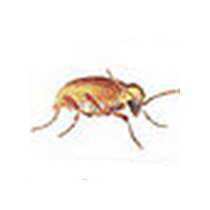(by the kind permission of Bayer)

Description
Order: Coleoptera ("sheath-wings")
Characteristics: Forewings hard and leathery, meeting along mid-line of dorsal surface: hindwings membranous, sometimes lacking; biting mouthparts; well-developed thorax; complete metamorphosis with egg, larval, pupal and adult stages.
Family: Ptinidae
Species Characteristics: Members of this family possess long, 11-segmented antennae, positioned between the eyes, plus a number of characteristics which give them a spider-like appearance: a stout body with hairy surface; a waist-like constriction at the base of the prothorax; 6 (not 8) long thin legs with 5-segmented tarsi.
-
Australian Spider Beetle (Ptinus tectus)
Adults, 2.5-4mm long, elytra clothed with dull-brown to golden-brown hairs; striae not distinct unless hairs rubbed off.
-
White-Marked Spider Beetle (Ptinus fur)
Adult, 2-4.3mm long; red-brown with yellow hairs; prothorax with dense cushion of pale hairs on each side; elytra with white scales; striae visible.
-
Golden Spider Beetle (Niptus hololeucus)
Adult, 3.0-4.5mm long; elytra and thorax clothed in silky golden-yellow hairs and fine scales.
-
Hump Spider Beetle (Gibbium psylloides)
Mite-like appearance, 1.7-3.2mm long; colour, shiny red-brown to black; lacks characteristic waist-like constriction; devoid of hairs.
Areas where found
Ptinus tectus originated in Australasia. It is a cosmopolitan species which reached Europe in the 19th century and is now widely distributed. It is rarely imported and infestations often originate in birds' nests. There are 2-4 generations per year in unheated conditions. All stages except eggs and young larvae can overwinter.
Ptinus fur is a closely related species which is also cosmopolitan in distribution.
The Golden Spider Beetle has similar feeding habits to the Australian species, exhibits a preference for moist places and will occasionally infest textiles, especially if soiled with grease. It is increasingly common in domestic premises. There is usually one generation per year in unheated conditions in temperate lands and peak activity is reached between August and November.
Gibbium psylloides. This insect is tolerant of cool conditions and can survive for long periods without food supplies.
Importance as a pest
Spider beetle larvae will infest all manner of dry animal and vegetable matter including grain, spices, fish meal, dog biscuits, dried fruit and a wide variety of miscellaneous debris. They will scavenge among the debris of neglected stores, and have even been reported infesting insecticidal derris powder. The larvae bore holes in which to pupate, and in so doing may damage packaging or the commodities themselves. They also contaminate commodities with droppings and silk webbing.
Adult beetles, too, will damage packaging including bags and sacks.
Gregarious and nocturnal, they spend the day in cracks and crevices amongst packaging and the fabric of the store. Consequently they can thrive in old buildings where they find many harbourages.
Life-Cycle
The female Australian Spider Beetle may produce 120 or more eggs over 3-4 weeks in early summer. They are laid either singly or in batches and, being sticky, will adhere to the substrate. At 20-25°C the eggs hatch in 3-16 days, giving larvae which are fleshy, curved, covered with fine hairs and relatively immobile, although they will rapidly curl up when disturbed.
Development takes at least 6 weeks, during which time the larvae moult 4 or 5 times. When mature, they wander in search of a pupation site where they will spin a cocoon cell in which to pupate. These cocoons are often found on the outside of cartons through which the larvae have bored. Adults emerge after 20-30 days and will live for as long as 12 months. If disturbed they will feign death. The full life-cycle takes 3-6 months, depending upon ambient conditions, and can take place in a temperature range of 5-28°C.
The life-cycle of the Golden Spider Beetle resembles that of the Australian species. The eggs hatch in 11-30 days at 15-20°C, the larvae live for 150-250 days and pupation takes 18-26 days, after which the adults live for up to 8 months.
Gibbium psylloides again has a similar life-cycle to the Australian and Golden Spider Beetles, but the adults are particularly long-lived, surviving for up to 1½ years. The optimum temperature for development, which can take place within the range 20-35°C, is 33°C, when it takes about 45 days.
Control
Assessment of infestation
A variety of trapping techniques are available for measuring stored product beetle infestations. These include pit fall traps, bait bags, insect probe traps, and adhesive traps. Whatever system is employed adequate records must be kept.
-
Hygiene/management
Stores should be soundly constructed to ensure maintenance of correct storage conditions and allow for easy cleaning. They should be insulated, well ventilated and damp-proof. Cracks and crevices, which may provide harbourages for the beetles, should be kept to a minimum.
Commodities should be stacked neatly above the floor level using pallets, away from walls and should not touch the ceiling. A gap between stacks will allow for ventilation, regular inspection, cleaning and, if necessary, treatment with insecticides. Appropriate stock rotation is important and if possible there should be a one-way passage of commodities through the premises. The careful choice of packaging can help to deter insect attack. Generally, thick, tough materials with a smooth, shiny finish are preferred. Packs should be strong and well sealed.
It is important to ensure that there are no food residues (stored commodities or secondary sources e.g. birds' nests) in which beetles can breed and develop to infest new materials. All infested commodities should be destroyed or fumigated. Stores should be kept scrupulously clean and farm stores should be thoroughly cleaned before harvest.
All grain taken into store should be dried to a suitable moisture content (MC) and temperature e.g. <15%MC and <15°C and maintained in that condition.
-
Insecticidal control
Insecticides can be applied to the fabric of stores concentrating on potential insect harbourages. Alternatively it may be appropriate to employ grain protectants.


